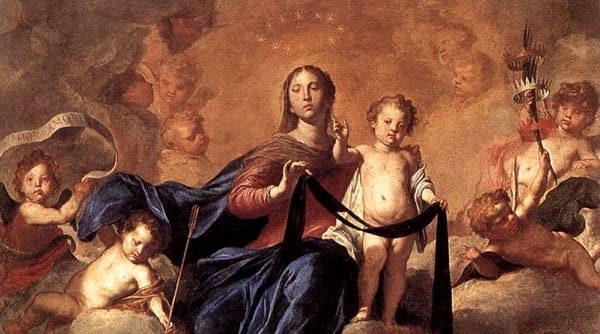Editor’s note: This post is based on a homily given for the Apostoli Viae Investiture Retreat at the Shrine of the Most Blessed Sacrament in Hanceville, Alabama for the Solemn Commemoration of the Feast of Our Lady of Mount Carmel, July 16, 2021.
In the Trastevere section of Rome, there is the Discalced Carmelite Church of Santa Maria Della Scala. It has the oldest pharmacy in the world, the relic of the foot of Saint Teresa of Avila, and a statue of Our Lady of Mount Carmel that once was above the high altar of Stella Maris Monastery and built over the cave of the Prophet Elijah on Mount Carmel. It also has the image of Santa Maria della Scala. This image hung over the stairwell of a house of a wealthy Italian woman whose crippled son one day became close to death. Cornelia, the midwife who took care of this woman’s son, in hope and trust amidst desperation took him and threw him before the base of the image and pleaded with Our Lady to save his life. Our Lady miraculously heard her prayer and brought the boy back to life. News spread quickly through the city and the church was built later by Pope Clement VIII in 1593.
Like the midwife who approached the image of Santa Maria della Scala, we throw open our hearts totally before Our Lady of Mount Carmel and her son Jesus on this day of investiture and profession. Today Jesus through Mary His Mother, Our Lady of Mount Carmel, longs to clothe me with her virtues and her heart so that I can be completely united to His heart.
We find ourselves like Elijah, filled with joys and frustrations amidst the victories and trials of the life of faith and the current state of the Church and the world. We can find the need to escape and regroup amidst the spiritual combat of prayer and the life of faith amidst its victories and defeats. That is why Elijah, after he slits the throats of the priests of Baal, climbs Mount Carmel (1 Kgs 18:41-45) and joins his head to his knees in prayer before the Lord. He enters the presence of God to be healed, refreshed, and strengthened for the next stage of the battle of faith that the Lord has called him to embrace. He looks for direction from the sea and receives none; he climbs the mountain seven times until the Lord gives him direction in the form of a cloud.
To climb up towards the summit of Mount Carmel to the fullness of divine union with Jesus brings the mysteries of my life into union with the mysteries of His own life. How do I ascend this mountain? Through love, knowledge, and action that leads to selfless, generous, faithful service to the Church and to souls—no matter who they are or where they may be on the way of faith.i It is in this ascent that I enter into the loving embrace of Jesus that is the call to holiness. To embrace this call to holiness and divine union is to respond to Jesus freely by doing the one thing that is necessary (cf. Lk 10:41-42), to anchor our actions and lives before the feet of Jesus through cooperating with the grace of the Holy Spirit in prayer while living the contemplative life in the world.
But like any climb, we can find ourselves on different paths of the same mountain of faith with a particular terrain in front of us. We will face the crosses of dryness, desolations in prayer, temptations, failures, and persecution amidst the graces and consolations in the ordinary life of faith. This will come sometimes from within our families and within the Church herself. Saint Teresa of Avila speaks of this participation in the cross of Jesus in the contemplative:
Those who do walk along [this path]…do not bear a lighter cross; and you would be surprised at the ways and modes in which God gives them crosses. I know about both types of life and I am well aware that the trials given by God to contemplatives are intolerable; and they are of such a kind that, were He not to feed them with consolations, they could not be borne. It is clear that, since God leads those whom He most loves by the way of trials, the more He loves them, the greater will be their trials; and there is no reason to suppose that He hates contemplatives, since with His own mouth He praises them and calls them friends.ii
The battle of prayer and mortification is central to climbing Mount Carmel. We are not alone in this battle for the Lord is with us and always gives us what we need for our salvation. So, Elijah receives rain from God as leaves Mount Carmel following the cloud from the sea. This represented the consolations and graces that he needed to be faithful to the Lord as he journeys off the mountain and back to his prophetic calling in the world.
Elijah’s receptive yielding and following of the cloud demonstrates a contemplative receptivity of faith. This disposition mirrors the same fiat and receptivity to grace that the Immaculate Virgin Mary would embody at the Annunciation before the Archangel Gabriel (cf. Lk 1:26-38). The preface of today’s Mass also speaks of this same reality in the following way:
It is truly right and just, our duty and our salvation, that we should at all times, and in all places, give thanks to You, O Holy Lord, Father Almighty, eternal God: Who through the rising cloud ascending from the sea, did wonderfully prefigure to the blessed Prophet Elijah the Immaculate Virgin Mary, and wished devotion to be paid to her by the children of the prophets; whom moreover the Blessed Virgin this very day received for the children of her love through the holy Scapular: mayest Thou vouchsafe to bring them, clothed in the same and dutifully dying to self, the more quickly to Thy holy mountain.iii
We see this same mystery play out in the Gospel where Our Lord from the cross gives to St. John and to you and I, His mother to be our mother (Jn 19:25-27). In meditating on this scene, the great Dominican theologian Reginald Garrigou-Lagrange speaks of the exchange between Jesus, His Mother, and John in the following way.
In this moment of anguish the words of the dying Christ touched their souls to their depths like a gentle balm, soothing their sufferings and their broken hearts. They brought immense consolation to John and to Mary too, for she could see into human souls and, looking into the soul of the beloved disciple, she could see what he himself could not: the living image of the Savior, the image that Mary would make perfect, and to render it ever more like its divine model. And so it happens often in the history of souls. When Jesus seems to draw away to test the confidence of His friends, He leaves His Blessed Mother to them, and He entrusts them to her care.iv
Jesus’ entrustment and yielding of His Mother to John and to us reveals that union between contemplation and action that is central to following Him in faith. My particular call to contemplation then helps me to receive the joys and trials of this world in a fruitful way and not to live solely for myself (cf. Jn 15:4-11; Gal 2:20). So often along the way of faith, I can be tempted to react in anger or in fear. This temptation can come to me from frustrations in prayer, failures endured, persecutions faced, sins relapsed into, and errors that I see in the Church and the world that pierce my heart. This temptation can lead to an unbridled fear that emasculates the faith for worldly gain, comfort, or influence (cf. Mk 8:36).
It can also lead towards a spiritual pride that tempts me to wield the sword of vitriol against legitimate evils in a way that can also impale both my own soul and that of others (cf. Jn 18:10-11). I can see this temptation affect not only me but also the people around me: whether it be family, friends, and even the pastors of the Church in their own sins and inactions.
Both in her joys and in the agony of the crucifixion of Jesus, Mary’s soul is like “a real garden of virtues, an oasis of peace and silence, where justice and truth reign, and oasis of security completely enveloped in the shadow of God and filled with God.”v It is in this garden that even in the midst of the trials, defects, brokenness, and crosses of this world that I can find a peace that goes beyond mere human desire; a peace that can anchor us against any storm and bring us to receive heavenly joys even in this life.
The nature of this aid that Our Lady gives us was reinforced at her sixth and final apparition at Fatima, Portugal in October 13, 1917, when she appeared both as Our Lady of Mount Carmel and Our Lady of Sorrows. She calls us to embrace the way of contemplation and of reparation through wearing her Brown Scapular and praying the Rosary for peace in the world and reparation for sin in the context of the First Five Saturday Devotion to Her Immaculate Heart. So as we climb in faith the mountain of Carmel and the mountain of the Cross, we ask Jesus through the intercession of Our Lady of Mount Carmel that we may be given the grace to fight the battle of prayer with fidelity and trust. In doing so, may we enter the heights of its summit and the embrace of Jesus through the hands of his Immaculate mother both in this life and the life of the world to come.
Endnotes:
i On the Charism of Apostoli Viae, 3 & 9-10; Reginald Garrigou-Lagrange, Our Savior and His Love For Us. Rockford, IL: TAN Books & Publishers, Inc., 1998, 341-350.
ii Teresa of Avila, Way of Perfection, Ch 18, n 1 taken from The Collected Works of St. Teresa of Avila, Volume Two, Translated by Kiernan Kavanaugh and Otilio Rodriguez. Washington, DC: ICS Publications, 1980.
iii Preface for the Solemn Commemoration of the Feast of Our Lady of Mount Carmel – 1962 Discalced Carmelite Missal.
iv Garrigou-Lagrange, Our Savior and His Love for Us, 335.
v Gabriel of Saint Mary Magdalen, Divine Intimacy. Rockford, IL: TAN Books & Publishers, Inc., 1996, 378, n. 2





